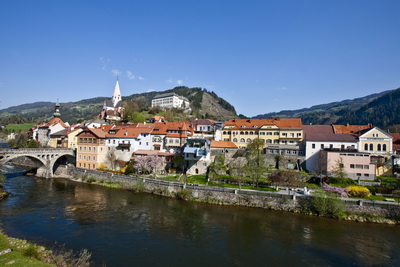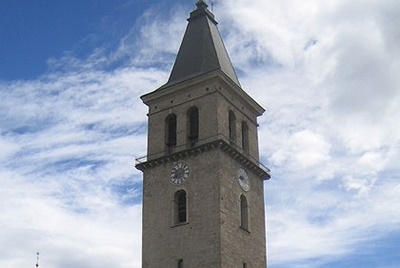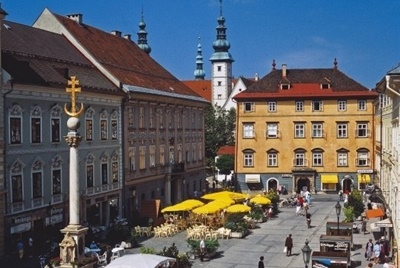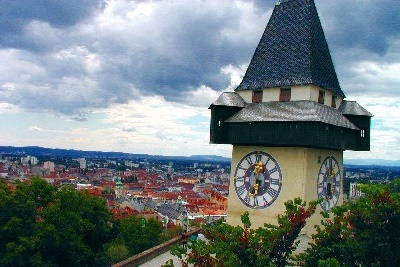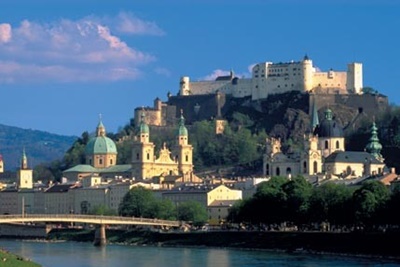Murau![]()
Murau is the nearest major city, located about six kilometers to the east from our hotel. The old town is picturesque, the old buildings are well preserved and give an idea of what it looked like in earlier times. Castle Liechtenstein towers above Murau - anyone interested in history will find here interesting anecdotes and intrigues, and with Anna Neumann an extremely exciting personality who survived three husbands and thus came into the possession of the castle. The opposite of the Schlossberg is the Mur promenade, where you can experience the green side of the city and where you can still see the elemental force of the river that gave the town and valley its name.
Judenburg![]()
Judenburg means "Jewscastle" and indeed there was a large Jewish community in the 13th century in this pretty Styrian town. The Jews had to leave the place in the course of the expulsions that took place all over Austria (and Europe) in the 1490s. In any case, Judenburg is a truly pretty place striving with history and since it is in an area with rather rural appeal, some sightseeing in a semi-urban setting might be a welcomed change. There are two interesting churches in Judenburg: The parish church, dating back to the 16th century, is an acceptable mix of Gothic and Baroque elements. The Magdalena Church was built mid 14th century, with several well-preserved features from the original building. The top-attraction of the town, however, is the Stadtturm or Town Tower which is 75 metres high and was built in the 15th century as a sign that Judenburg rules. Since then, the tower was on fire a couple of times and relatively little is left of the original building.
Shopping tip: Arena Fohnsdorf
Klagenfurt![]()
Klagenfurt, capital of Carinthia, lies on the edge of the wide Klagenfurt basin, which is bound on the south by the wood ridge of the Sassnitz range, with the Karawanken rearing up behind. Although Klagenfurt is an important traffic junction and a busy industrial and commercial town, it has an attractive old quarter with picturesque little cultural sights. Founded in 1161 as a market village, Klagenfurt was granted its municipal charter in 1252. The old town was destroyed by fire in 1514. Stroll the area then go to the cathedral, which has elaborate baroque decorations. Klagenfurt also has a smaller parish church with a high tower. Carinthia′s main attractions, however, are outside of Klagenfurt. The Lake Wörthersee and the cities of Velden and Wörth are popular for a summer stroll. They can be a bit crowded, but there′s plenty to do in terms of water sports. There is also a famous casino nearby.
Shopping tip: City Arkaden Klagenfurt am Wörthersee
Graz![]()
The capital of Styria is located on the Southern outskirts of the Alps, a very pleasant landscape of smaller hills.The clock tower is the true symbol of Graz. The clock face has an unusual story; for a long time the 5.4 m long hand was the only one which indicated the hour. The smaller hand (2.7m) which shows the minutes were added later, which explains the unusual reversal in size. In the clock tower hangs one of the oldest bells in the province (1382). This former court church was built between 1438 and 1464 on the orders of Emperor Friedrich III. Only in the year 1786 did this large and light church become the Cathedral of Graz. On the south western corner of the exterior, you can find the "Landplagenbild" form the year 1485. This faded fresco is a reminder of the 1480 Plagues (Turks, Plague and locusts), which brought Graz into a state of fear and horror.
Shopping-Tips: Shopping Nord
Salzburg![]()
At some point between the magnificent Mirabell gardens, the mighty Fort Hohensalzburg fortress and the picturesque spires that dominate the city′s skyline, you might feel overwhelmed by impressions. The city has several noteworthy art galleries, a nice museum of contemporary and modern art, several specialist history or culture museums, a big natural history museum and the particularly recommendable Salzburg Museum, a museum for history and culture of the city and province. The mightiest fortress of central Europe, a powerful castle sitting in a prominent position, undoubted Salzburg′s prime attraction and most dominant feature of the city′s skyline: the "Festung Hohensalzburg" or "Hohensalzburg Fortress" ought not to be missed at any Salzburg visit. The house in Getreidegasse 9 was the living place of the Mozarts between 1747 and 1773 and here Wolfgang Amadeus Mozart was born on the 27th of January 1756. The museum at his birthplace now hosts precious relicts such as the violin that Mozart used to play when he was a child, the time of baby Mozart, his concert violin, his Clavichord, portraits, letters and other memorabilia of the Mozart family.
Shopping-Tips: Europark Salzburg
